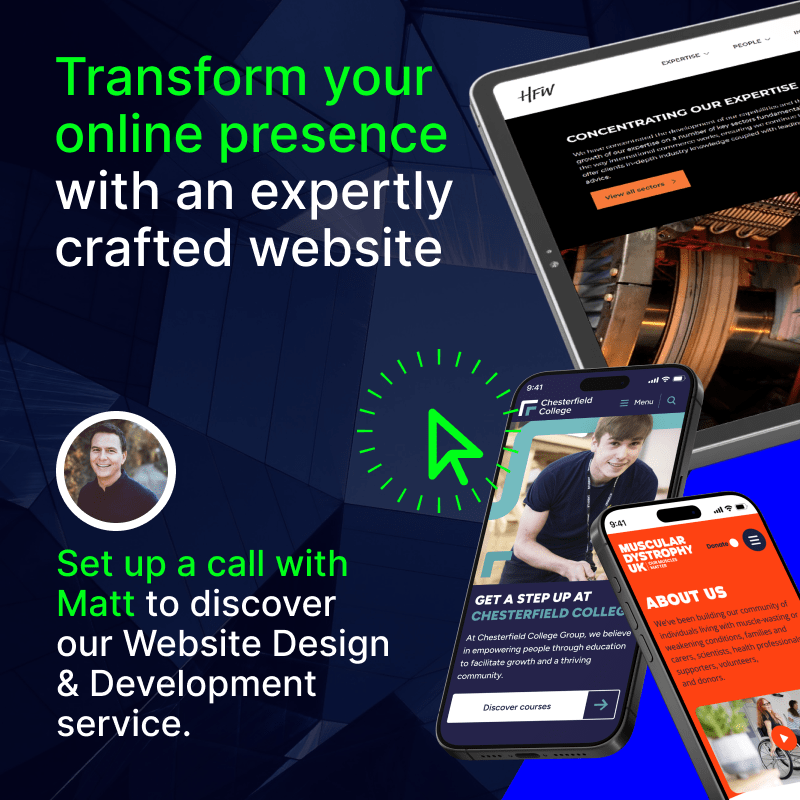What is User-Centred Design (UCD)? Principles and Examples
Good design isn’t just about how something looks — it’s about how it works for real people. A website or app that confuses users, slows them down or frustrates them won’t succeed, no matter how sleek it looks. That’s why user-centred design should always be a priority.
In particular, we’re talking about user-centered design for your website and digital presence.
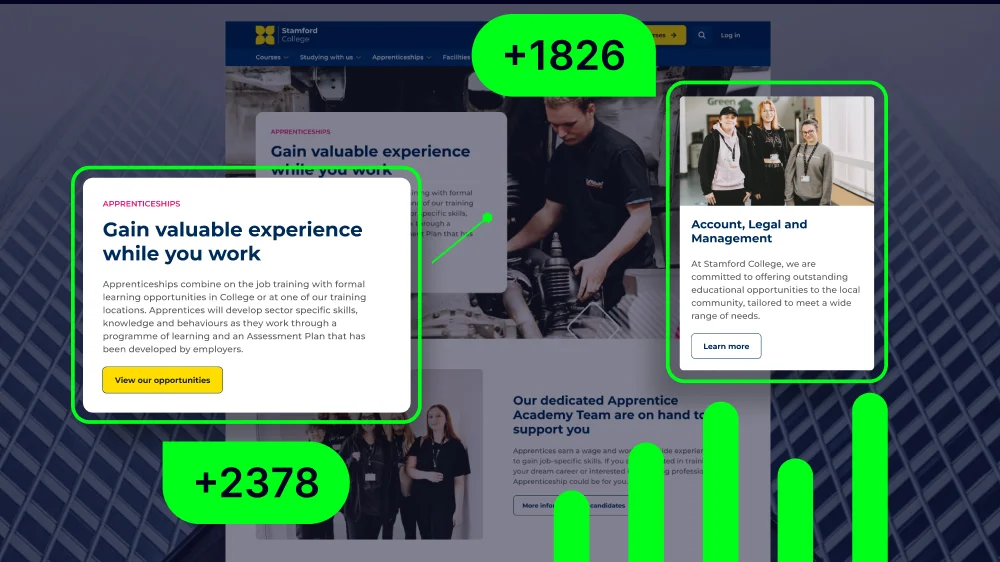
Olly Clapp brings creativity and expertise to his role as a Senior Designer at Itineris, a dynamic digital marketing agency renowned for its innovative strategy, branding, and web development solutions. With expertise in conversion optimisation, accessibility, and brand performance, Olly consistently delivers impactful projects that drive client success.
As you guessed from the name, user-centred design puts your users at the heart of every decision. It’s all about creating digital experiences that are intuitive, accessible and genuinely valuable to your unique audience.
What’s important here is that a website design that works for another brand won’t work the same for yours. Your users are unique, so they require a digital experience that matches their unique habits and intent.
If you’re putting together a new website or optimising any other area of your digital strategy, understanding user-centred design is key to achieving positive results.
In this guide, we’ll break down what user-centred design is, why it matters and how to apply it effectively. This will help you create experiences that people love and keep coming back to.
What is User-Centred Design?
User-Centred Design (UCD) is a way of designing digital experiences that put real users first.
It’s all about understanding user needs, behaviours and challenges. Instead of making assumptions, UCD relies on research, testing and feedback to shape the final product.
Unique data insights are required for effective UCD, as you need to understand what your audience is up to in order to properly optimise your website.
Importantly, UCD is also never a cut-and-paste process, as it’s based around your unique audience. So, while you can apply UCD principles to your website, there’s no such thing as a universally user-centred design.
The UCD process is iterative, meaning it evolves over time. Designers create, test, refine and repeat until they achieve the best possible experience.
Ultimately, the goal is to make digital products that are easy to use, accessible to everyone and enjoyable to interact with.
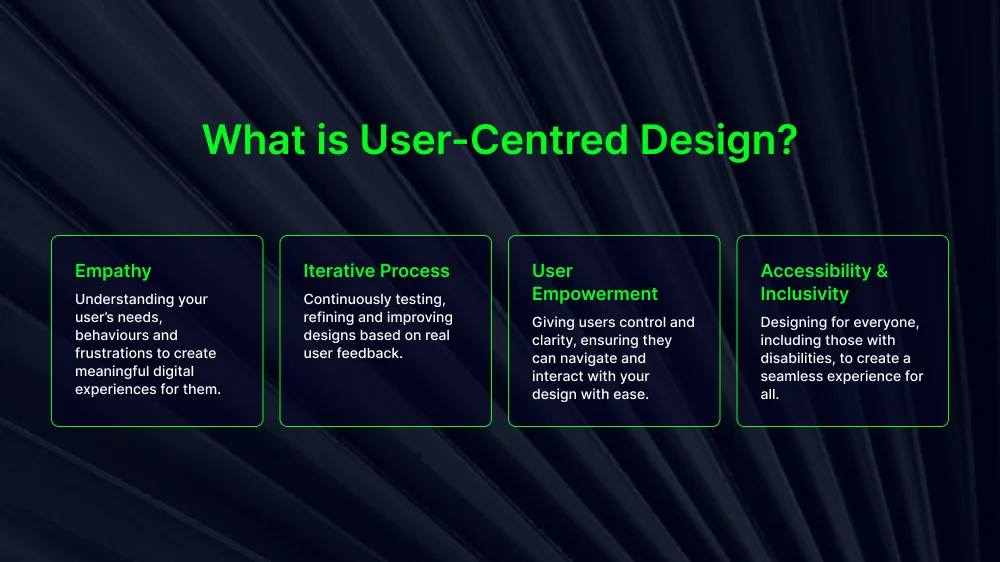
At Itineris, a key element of any web design project we work on is gaining unique audience insights. This helps us create and optimise designs that are most effective for each individual use case.
The Benefits of Putting Users First
Quite simply, focusing on user needs leads to better digital experiences and stronger business results.
When you design with users in mind, you create products that are easier to use, more engaging and ultimately more successful.
Clear Requirements
First, taking a user-first approach leads to clearer requirements.
Instead of guessing what a product should do, you base decisions on real user needs. This keeps projects on track and reduces costly revisions later.
Improved User Value
A UCD approach should increase value per user.
People are more likely to stay loyal to brands that offer a smooth, enjoyable experience. When two businesses offer similar products, the one with better usability wins.
Less Waste
User testing and research help reduce waste in your digital experiences.
By validating ideas early, you avoid spending time and money on features that don’t work. This makes development more efficient and improves conversion rates.
Broader Business Benefits
Designing digital experiences for users offers benefits that go beyond your digital products alone.
User insights gathered during research can help inform other areas of a business, from customer service to product development. Sharing this knowledge helps teams stay aligned with what customers truly need.
And by putting users first, you can also extend a product’s lifespan. A well-designed solution remains useful for longer, reducing the need for frequent redesigns.
However, user needs change over time, so continuous feedback and iteration are essential to staying relevant.
The Core Principles of User-Centred Design
User-centred design is built on a few key principles that ensure digital experiences meet real user needs.
The first is user research. Before designing anything, you’ve got to understand your audience.
This means identifying their goals, pain points and, importantly, their behaviours. Research methods like interviews, surveys and user testing help uncover what people need and expect.
While this is helpful for getting a headstart on understanding your target audience, the most important bit is understanding how they interact with your brand online.
To access this, you’ll need unqiue data insights that monitor your site and broader online presence for user behaviours. This is only possible by taking an iterative approach to UCD.
Accessibility and inclusivity are also essential. A well-designed digital product should work for everyone, including those with disabilities.
This means considering factors like screen reader compatibility, colour contrast and easy navigation. You can read our more detailed guide on accessibility standards for more details. Ultimately, when a product is accessible, it reaches a wider audience and provides a better experience for all users.
As mentioned above, UCD is an ongoing process and not a one-time task.
Iterative testing and feedback loops help refine designs over time. By testing prototypes, gathering feedback and making improvements, designers can fix issues early and ensure the final product is as user-friendly as possible.
This works because UCD is tied to data insights and user behaviour. You can’t get your site fully optimised until you monitor how users engage with it, and then make adjustments over time.
Data-driven decisions lead to better outcomes. Analytics, heatmaps and A/B testing provide valuable insights into how users interact with your website or app. Instead of guessing what works, designers can use real data to improve layouts, content and functionality.
By following these principles, businesses create digital experiences that are not just functional, but engaging, accessible and easy to use.
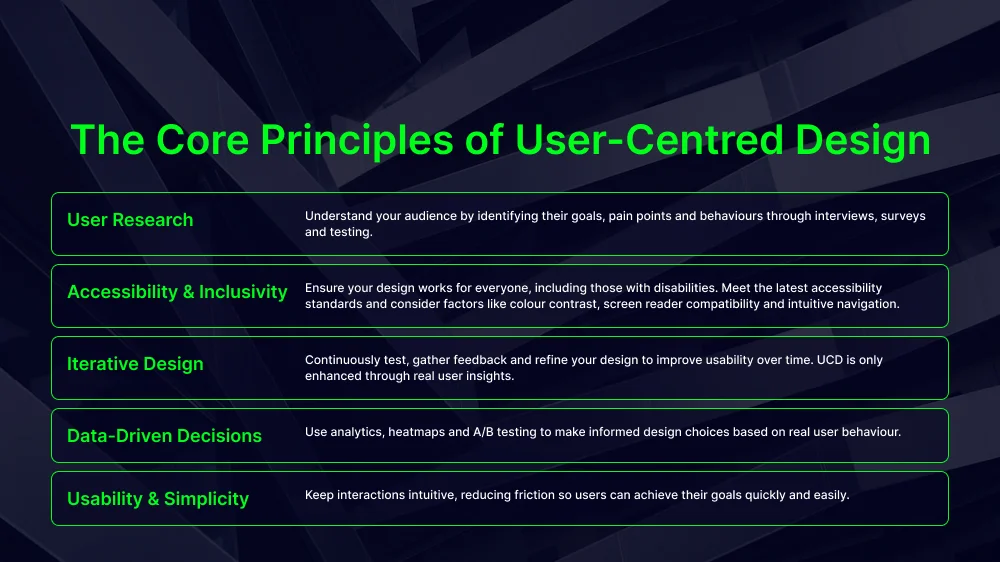
Understanding User-Centred Design vs Human-Centred Design
UCD and Human-Centred Design (HCD) share a common goal: creating products that work well for people.
However, there’s a key difference in their approach, and you shouldn’t confuse one with the other.
Human-Centred Design takes a broad perspective. It focuses on designing solutions that benefit people in general, considering human behaviour, psychology and accessibility. It aims to create products that are useful and inclusive for a wide audience.
User-centred design is more specific. It focuses on a defined group of users, considering their needs, behaviours and challenges at every stage of the design process.
Rather than designing for ‘everyone’, UCD ensures that a product works well for the exact users it’s meant to serve.
This might mean limiting your audience, but it also means providing the best possible experience for your most relevant audience.
For example, a human-centred approach to designing a healthcare app might aim to make it intuitive and accessible for all patients. A user-centred approach would go further, tailoring the app specifically for elderly users, ensuring larger text, simple navigation and voice control options.
Both approaches value user experience, but UCD takes it a step further by involving real users in research, testing and iteration.
By focusing on specific user needs, businesses can create more effective, engaging and successful digital experiences — even if they apply to a smaller user group.

Source: Justinmind
Accessibility and User-Centred Design
As we mentioned, accessibility is a major part of UCD. In fact, digital accessibility is so important that it deserves its own special mention beyond the typical principles of UCD.
Quite simply, a well-designed website or app should work for all users, including those with disabilities.
Not only is having a WCAG 2.2 AA standard website a requirement these days, but ensuring your site is fully accessible improves user experiences for everyone. And when your site provides a better experience, it will also see greater results in conversions, engagement and SEO.
Usability ensures that interactions are all smooth and intuitive, reducing frustration. Desirability focuses on making the experience enjoyable, while inclusivity ensures no one is left out.
If you’re creating or updating your website, accessibility is a factor you simply cannot overlook.
The 5 Step Experience Success Ladder
Creating a great digital experience isn’t just about making something work. It’s about moving beyond basic functionality to create products that users enjoy, trust and rely on.
The Experience Success Ladder is a way to measure how well a product meets user needs, with each step bringing greater value to both users and businesses.
At the base level, a product must be functional — it works, but that’s about it.
Next, it becomes usable, reducing frustration but still lacking polish.
A comfortable product is next. This is a product that feels intuitive and natural, while a delightful experience makes users genuinely enjoy their interaction.
The highest level, meaningful, is where products truly impact lives, creating deep connections and lasting loyalty.
Each step up the ladder makes your product more effective, engaging and valuable. The goal is to create something that users don’t just use, but love.
When you’re optimsing your design to be user centred, focusing on these principles can be an excellent guide to keep the process on track and consistently improving.
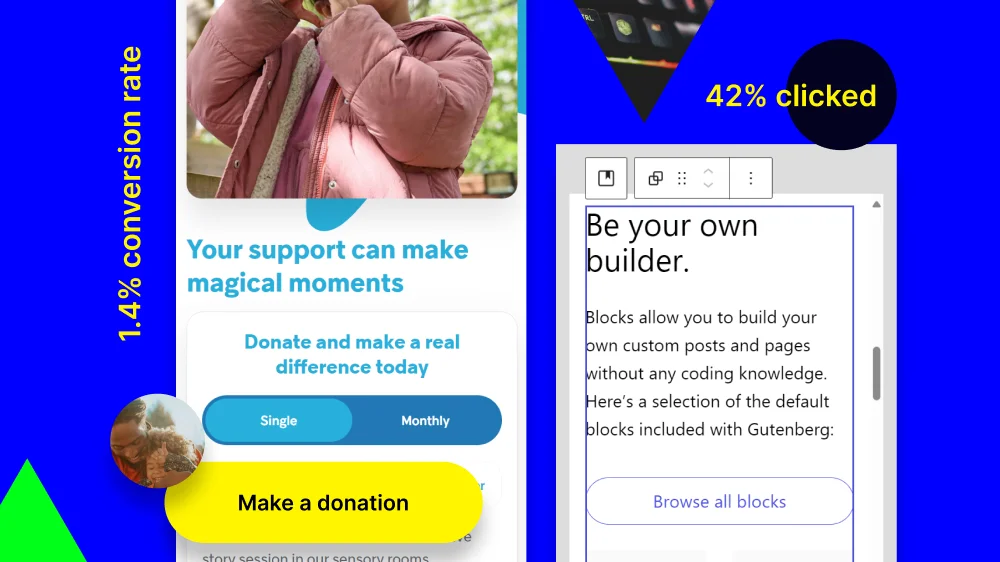
How to Implement UCD in Digital Projects
Implementing UCD in digital projects involves a few important steps. Each stage helps create a product that works well for real users.
The first step is user research and discovery. This means gathering insights through surveys, interviews and data analysis.
The goal here is to understand the audience — who they are, what they need and what challenges they face. Creating user personas based on this research helps guide design decisions.
Next is information architecture and wireframing. This stage focuses on structuring content and navigation so users can find information easily.
Wireframes act as blueprints, mapping out layouts and interactions before detailed design work begins.
Prototyping and design come next. Prototypes are interactive models that allow teams to test ideas before full development.
Design choices, such as colours, typography and UI elements, should be based on user insights to enhance usability and engagement.
Testing and validation are crucial here. Usability testing helps identify pain points and areas for improvement. Gathering real user feedback ensures that the product is intuitive and accessible before launch.
The process doesn’t stop once the product goes live. As we’ve already mentioned, iteration and optimisation are ongoing. That’s what truly makes UCD.
By tracking user behaviour and analysing data, teams can refine the experience over time. Small, continuous improvements help maintain engagement and keep the product aligned with user needs.
It;s worth mentioning here that far too many digital projects fail because they don’t put users first. Avoiding some common mistakes can make a big difference in creating a successful product.
First, skipping testing is a common issue, often due to time or budget constraints. But without testing, problems go unnoticed until it’s too late. Even small-scale usability tests can reveal valuable insights and prevent costly redesigns later.
Relying on assumptions instead of real data also leads to poor decisions. Just because something looks good doesn’t mean it works well.
Using analytics, heatmaps and A/B testing ensures decisions are based on how people actually use the product, not guesswork.
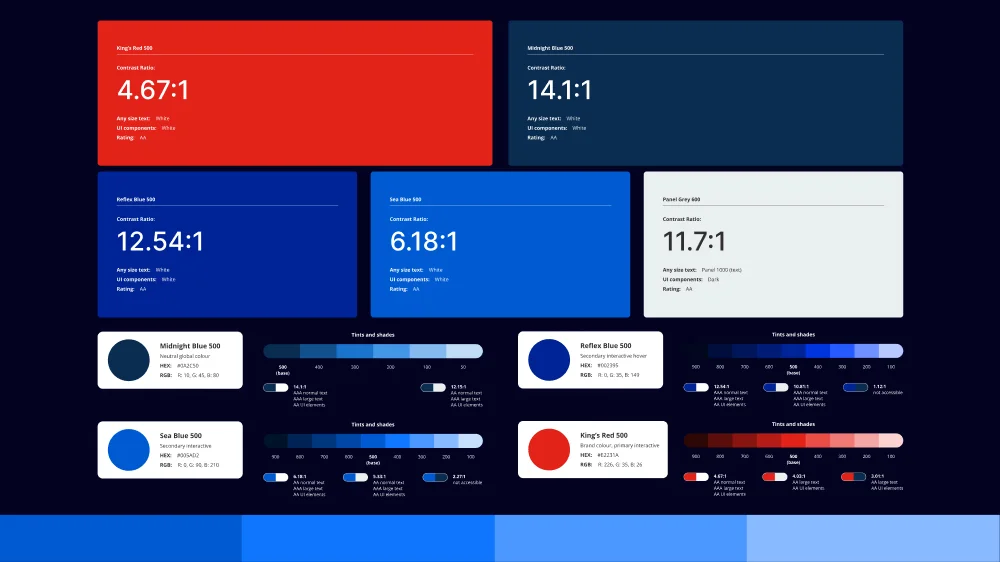
Investing in User-Centered Design for Your Digital Presence
User-centred design is the foundation of your digital success. When you put users first, you create experiences that are intuitive, engaging and built to perform. It’s a straightforward concept, yet it’s something that far too many businesses get wrong by sticking to generic website templates, or simply leaving their website alone instead of continuously optimising it.
From clearer requirements to better conversion rates, the benefits of UCD are undeniable. Most importantly, prioritising user needs doesn’t just attract more customers; it builds loyalty and long-term value for everyone that engages with your brand online.
If you want a digital presence that works for your audience, and drives real results, it’s time to invest in UCD. Get in touch with us to create user-centred digital experiences that deliver. Let’s build something your users will love.

